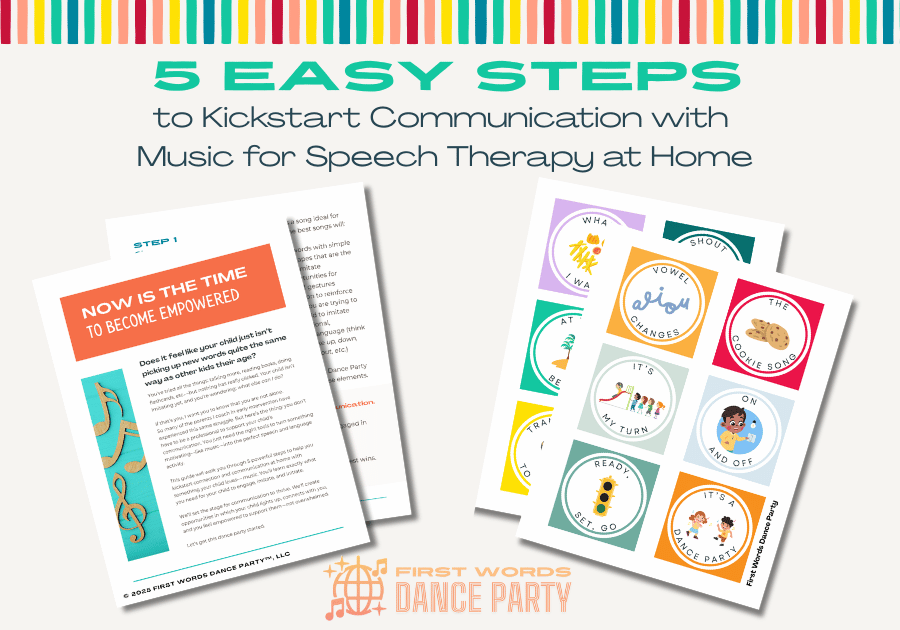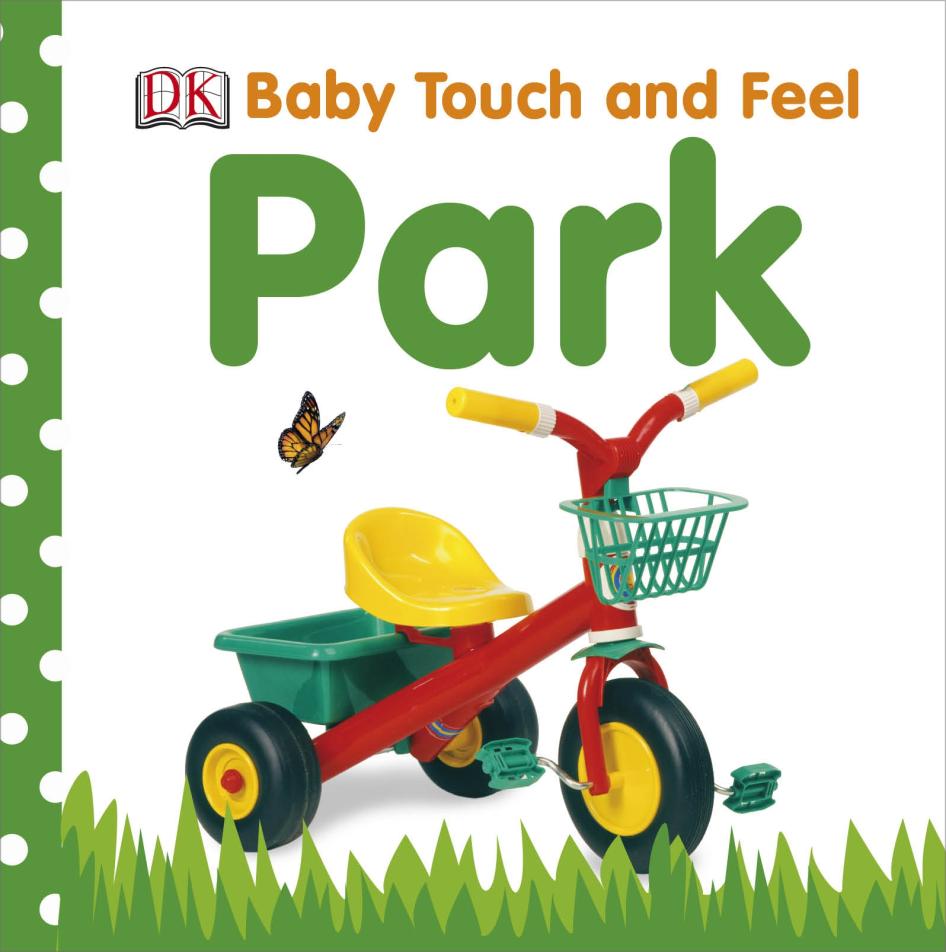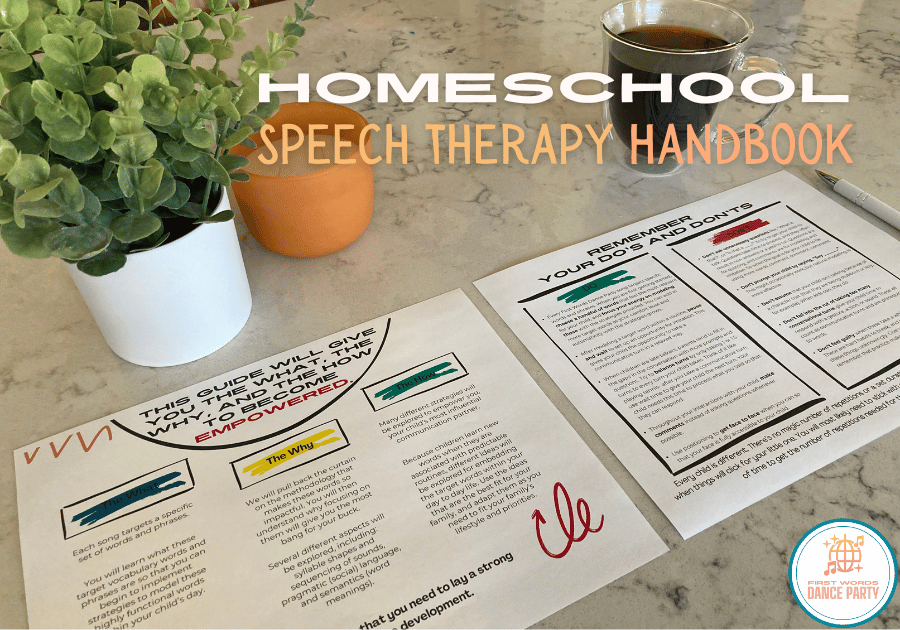What is receptive language and why is it so important for toddlers?
- 0 comments
This article is for any parent or caregiver wondering, what is receptive language? While most people use the term “speech” to refer broadly to speech and language development, there are actually several different but related skill areas within it.
This article will walk you through receptive language and how it differs from, but is closely related to, expressive language and speech. You’ll discover why receptive language is so important for speech and language development and how you can give your toddler’s receptive language a boost!
If your child isn’t using many words yet, you may be unsure of what to do and what not to do- and you’re not alone. Many parents I coach in early intervention feel stuck, frustrated, or overwhelmed when their child won’t imitate their words.
That’s why I started creating music for speech therapy that weaves in the strategies we use everyday in early intervention.
You can download a free guide to discover 5 easy, parent-friendly steps to use songs for speech therapy to spark connection and communication with your child. As a bonus, you’ll receive song boards with cards for every First Words Dance Party™ song, so your child can make choices and initiate.
Why Don’t We Hear More About Receptive Language Development?
For as much lip service as speech gets during the toddler years, we don’t hear about the importance of receptive language enough.
From my experience coaching the parents of children with speech delays, it’s just not obvious to most parents what receptive language skills to be working on with toddlers (don’t worry- we’ll go through that so you know what to do).
I can tell you this. Many of the children I work with have receptive language delays in addition to their (more obvious) speech delays. It is crucial that we incorporate ways to expand upon these kiddos’ receptive language skills, or we’ll only make limited progress with their ability to talk.
When we take the time to purposefully support a child’s receptive language skills, we see the beneficial impact on their speech ten times over.

What is Receptive Language?
The most straightforward receptive language definition is simply the understanding of language. Receptive language involves taking in what someone is saying and processing that jumble of sounds and words to make sense of the meaning behind it.
Infants take in all of the language spoken to them over that first year of life and they quickly learn which kinds of sounds, like “ba” and “ma”, are speech sounds used within their home language.
They also learn which sounds (like a tongue click or a raspberry sound) are sounds people can make, but aren’t units of language. It’s really pretty fascinating that tiny little babies are wired to do this.
Receptive Language Examples for Toddlers
For toddlers, receptive language milestones include:
following directions
understanding the names of objects and people
identifying body parts and clothing
pointing to pictures in a book when an adult labels them
understanding action words
understanding descriptive words
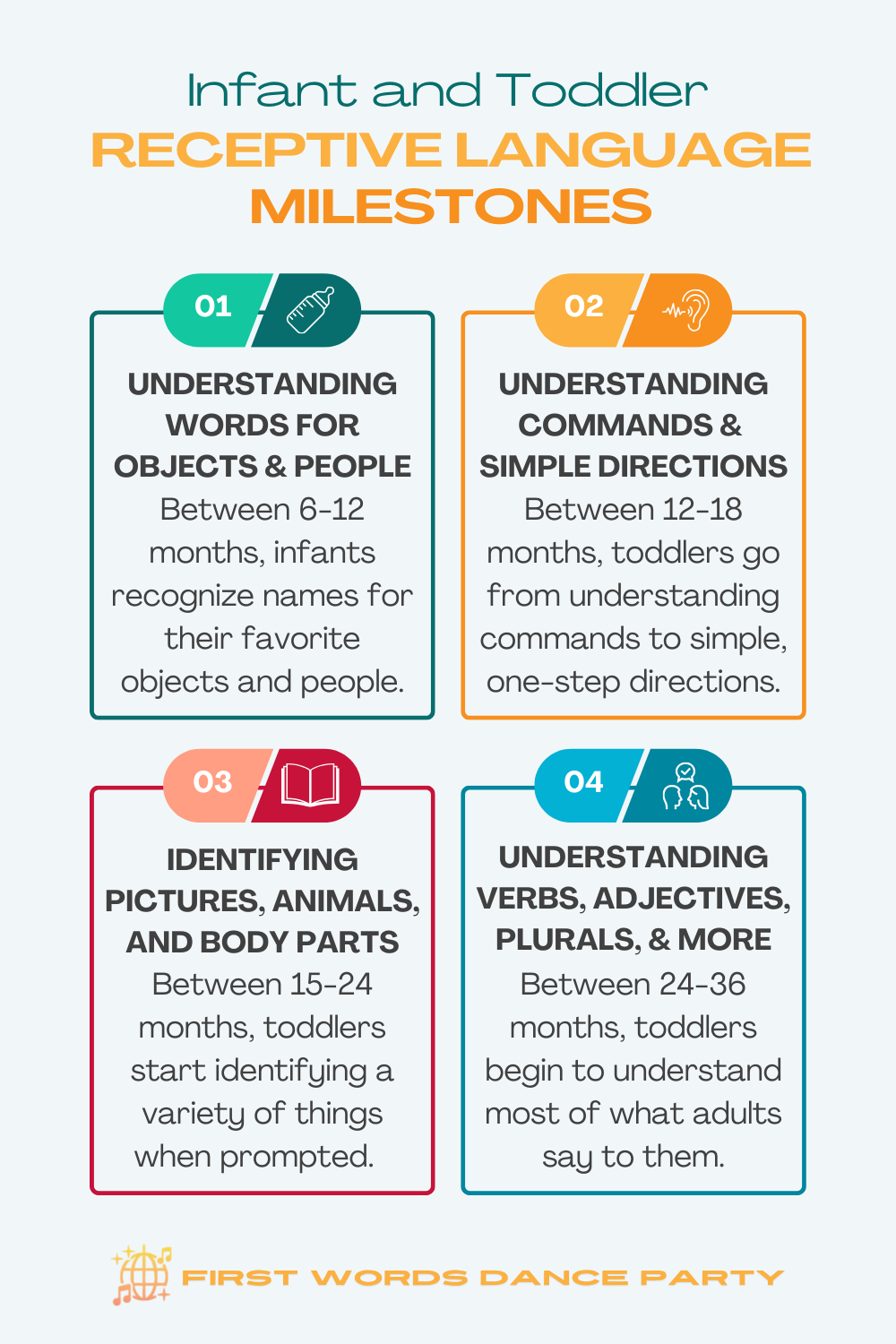
What is expressive language?
Expressive language refers to the words and phrases that a child can say. For toddlers, this includes the ability to express their wants, needs, and other functions.
It involves the ability to use words as symbols that represent concepts- for example, that when you string together the three different sounds in the word “ball”, it becomes a symbol for the round object that bounces and rolls across the floor.
Are receptive and expressive language the same thing as speech?
I mentioned earlier that we tend to use the term “speech” broadly. I even did it earlier in this article to keep things from getting too wordy.
Technically speaking, the term “speech” is more specific than how we tend to use it. While receptive and expressive language have to do with the symbolism that all of these words hold, the term “speech” has more to do with the actual sounds within the words.
Speech refers more specifically to how and where sounds are produced within the mouth with the articulators, like the tongue, teeth, and lips. A child can have very strong language skills but struggle with articulation, and as a result, be difficult to understand.
That being said, because these terms are all very nuanced, it is totally normal to refer to speech and language development as just “speech”. In fact, when a toddler isn’t talking yet at 18 months or older, the term “speech delay” is the widely accepted term. It’s short and sweet, and people know what you mean.
The same goes for the term “speech therapy”. Speech-language pathologists spend lots of time targeting language skills with toddlers with expressive and receptive language delays. And, when they discover particular sounds that are causing the child trouble, they target those sounds with the individual child in a meaningful way.
So we say “speech therapy”, even when a child may actually be receiving therapy for an expressive and/or receptive language delay.
Receptive language delay, receptive language disorder, and mixed receptive expressive language disorder
Children can have a delay or disorder in one aspect of language or both. For example, a toddler who has met receptive language milestones typical for their age but isn’t meeting expressive language milestones is likely demonstrating an expressive language delay.
Some children are really good at labeling objects and using rote phrases, but they have a hard time understanding directions and questions. Those kiddos are likely demonstrating a receptive language delay.
After being assessed by a speech-language pathologist to determine areas of strength and areas of need, a child may be diagnosed with a receptive language disorder or an expressive language disorder.
A child whose language skills are significantly behind what is expected for their age in both areas of language may be diagnosed with mixed receptive expressive language disorder.
How to improve your child’s receptive language skills
Receptive language skills really do serve as a foundation for expressive language. If you’ve ever tried to learn a second language, you can draw upon that experience to relate.
For an English speaker learning Spanish, for example, it is generally easier to understand the gist of what someone is saying in Spanish than it is to figure out how to put that same sentence together in Spanish. You might pick up on a few key words and then figure the gist of the sentence out with context clues. Saying that same sentence accurately, though, requires additional skills.
Receptive and expressive language are two different but very interrelated things. When we have a solid understanding of the meaning of a word or phrase, we are in a much better position to use that word correctly and naturally in our interactions with others.
So with that background, let’s explore some simple ways you can support your little one with their receptive language skills.
Practice identifying pictures in books to expand receptive vocabulary
Start by giving your child purposeful opportunities to identify pictures in books when you label them. Many parents find it pretty intuitive to ask their child to label pictures by asking, “What’s this?” or “What’s that called?” while looking at books; these kinds of prompts target expressive language.
Asking your toddler to point to pictures as you name them, though, will increase their participation within the book routine and, in turn, boost receptive language skills. And most toddlers are usually able to identify pictures in a favorite book before they are able to label them.
If it’s a favorite book you’ve read before and they have heard you name the pictures, than you’ll already have done the teaching necessary for this activity.
You can say to your child, “Where is the puppy?”. Wait several seconds to give them time to process your question. If they don’t respond, answer the question by pointing to the picture and saying, “There’s the puppy.”
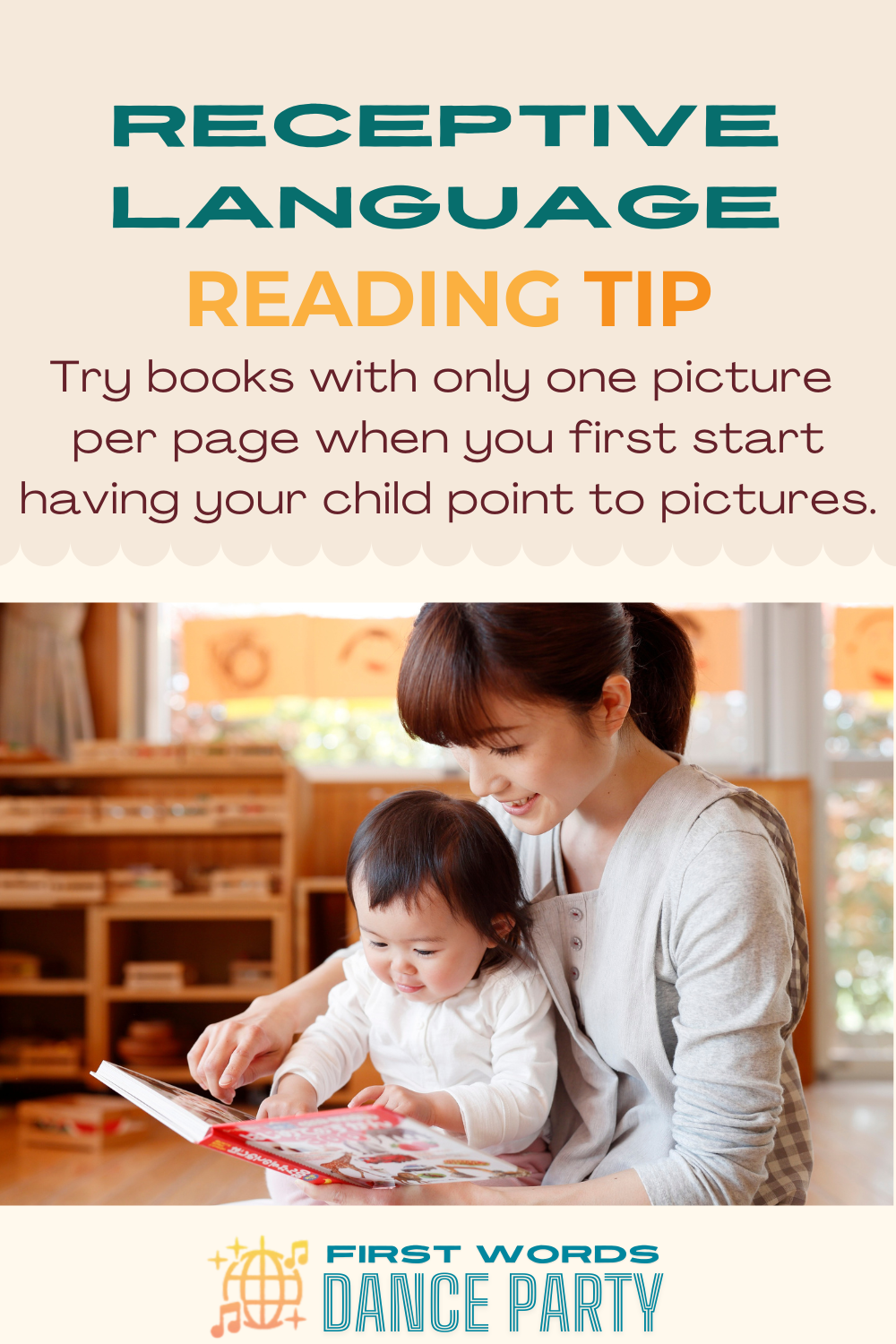
Pro tip: If your child is struggling to point to pictures when you name them, focus on books where there is only one picture per page. These are much less visually overwhelming and help to set kiddos up for success.
The DK series does this really well with simple pictures that are touch n feel.
Identifying body parts
Did you know that having your child point to body parts, like their eyes, ears, nose, and tummy is a way to increase receptive language?
Start with facial features, like eyes, nose, and mouth. Make it light a fun by asking, “Where are your eyes?”. Wait at least three seconds before you give the answer. You can help your child to point to the body part you are teaching, again making it fun by being enthusiastic.
Diaper changes are my favorite time to teach body parts to toddlers, because you are already face to face in close proximity, and doing so can make diaper changes a little more fun. Start with facial features, like eyes, nose, and mouth.
You can change it up and ask, “Where are mommy’s eyes?”. Even if you only did this for one diaper change per day, that would be seven times in one week- and that consistency pays off!

Use self-talk and parallel-talk to model all kinds of language
Of all the things you can do to encourage receptive language development, self-talk and parallel-talk should be at the top of your list.
Parallel talk means describing and narrating what your child is doing. Self-talk is just like parallel talk, except you describe what you are doing.
To do this successfully with toddlers, keep your phrases short and don’t be afraid to be repetitive- little ones learn from repetition.
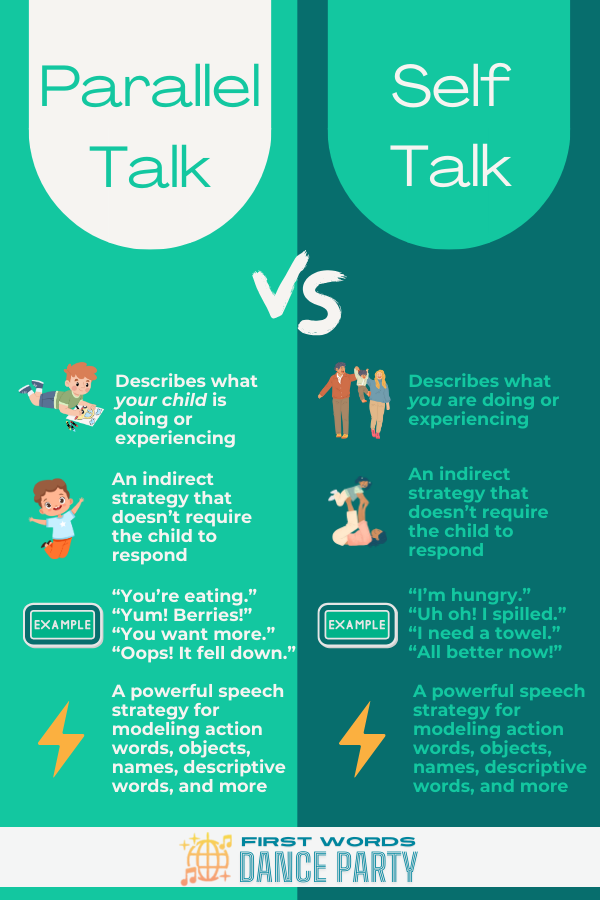
When you make comments about your actions and your child’s actions with self-talk and parallel talk, you can model all kinds of language. These two strategies work wonders for teaching verbs (action words) and descriptive words.
These two strategies are golden because they increase not only receptive language, but expressive language, too.
For more about this strategy and other tips and tricks you can use to create a language-rich environment, check out this article.
Start with one step directions
The very first directions little ones are able to follow are simple commands, like “come here” and “sit down”.
Once they understand those basics, then they are able to follow simple, one-step directions that involve objects, like “Go get your shoes” and “Put the wrapper in the garbage”.
Pausing and waiting for a few seconds after you give a direction is super important. We often have a tendency to repeat the direction again or ask it again as a question (“Can you put it in the basket?”) - but when we layer on additional questions and directions, it can be overwhelming.
Your child may still be processing the first thing you said, but then has to start over with their processing when you layer on a second and third instruction.
If you’ve waited several seconds and your child still hasn’t responded, it’s time to model. Show your child what you mean by “throw it away” or “get your shoes”. You can guide them to where the garbage or shoes are and use your hands to help them to be successful.
Directions are harder for little ones with a receptive language delay
Pro tip: If you’ve been stuck on directions with your child for a while, it may be because they don’t yet know how to use a variety of different actions with objects. Some children need extra practice learning how to do things like put in, take out, open and close, and move objects back and forth and up and down.
This resource from the First Words Project will help you to determine which actions with objects your little one is using and which ones you could try working on.
Your kiddo may also benefit from additional strategies, like using visuals and sign language, to help them with directions and transitions. Check out this article on strategies to support kids through these things in order to avoid the challenging behaviors that often come with a receptive language delay.
Have toddlers help with simple tasks
When I say to have your child help you with simple chores around the house, know that I am doing air quotes around the word “help”.
When you have your child help you with chores like laundry, preparing a simple snack, and unloading the dishwasher, it will probably take longer than if you just do it yourself.
But hear me out- when you include your child in simple chores, they will gain invaluable experience with using actions with objects while also hearing some pretty fantastic language models.
Toddlers understand language best when they are actively engaged in doing something. When a child is actively engaged, they tune in to the people around them and are ready to soak in what is being said.
The very best way to expand a child’s receptive vocabulary is to give them a productive role in whatever it is that is taking place.
Let’s think about something as simple as a chore like unloading the dishwasher. Not only will your child gain real-time exposure to object words like cup, spoon, and fork while they help to put things away, but there are many opportunities here for action words and descriptors, too.
You can model the words in, out, open, and close as you put things away. You can model descriptive words like big and small as you sort the big spoons and the small spoons in the silverware drawer.
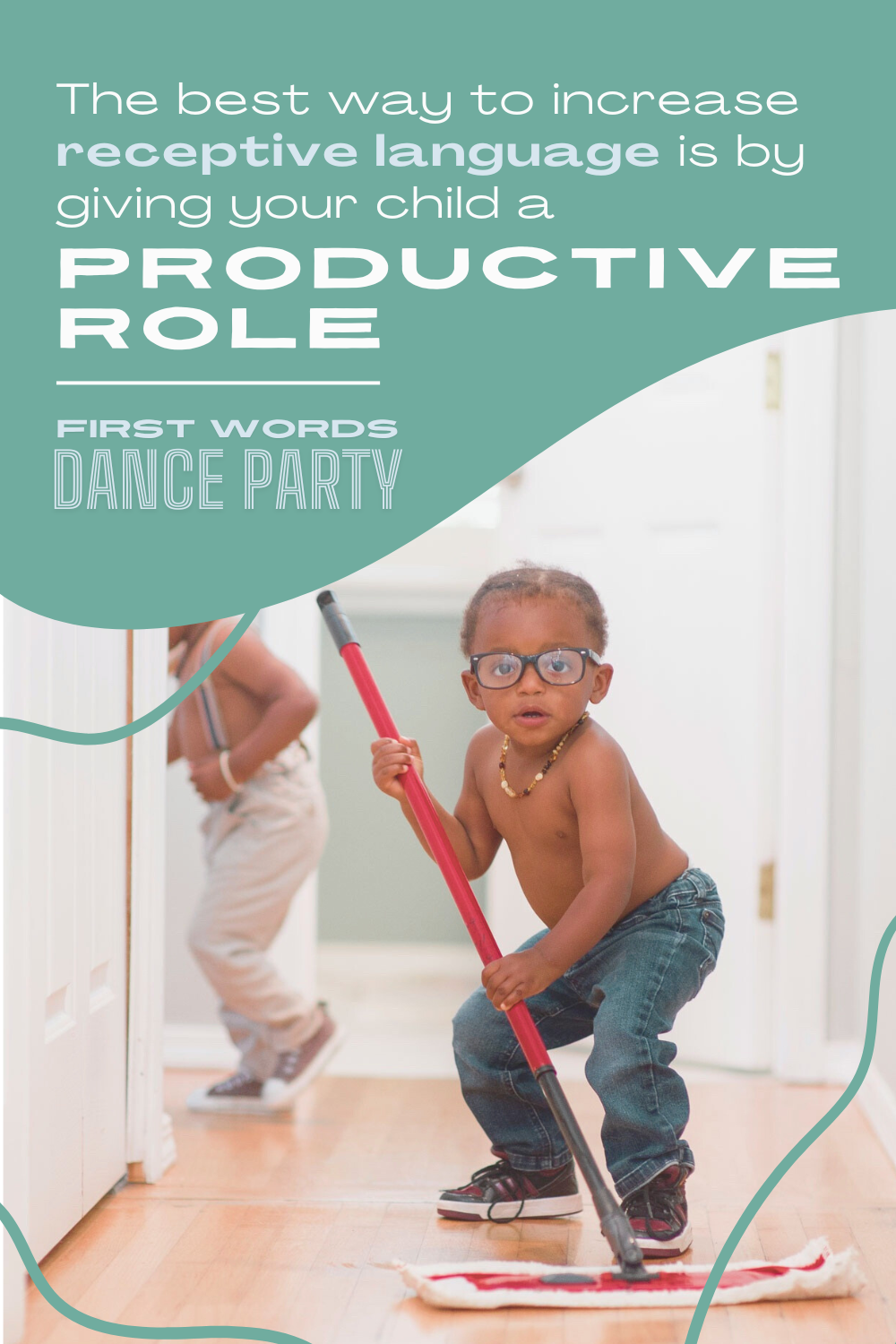
Play is absolutely essential for receptive language
This may sound basic, but it’s so important that it still has to be mentioned.
There’s a saying that “play is the work of the child”. Maria Montessori originally said it, and Fred Rogers elaborated upon it. When toddlers play, they make sense of the world around them.
Some parents find it to be fairly intuitive to play on the floor with their kids. For others, it’s not easy at all. In fact, it can be really hard- especially when there are competing priorities, like housework, the needs of ourselves and siblings, and work demands.
But when you can carve out the time to get down on the floor and play alongside your child while using those parallel talk and self-talk strategies, it really builds expressive and receptive language.
More ideas for reaching receptive language milestones
If you ever feel like you could use a little help coming up with things to do to keep your little one engaged and learning, check out Zero to Three’s A Year of Play. This amazing resource is organized month by month into three areas: activities for talking, activities for reading, and activities for play. It breaks these down further into activities for infants and toddlers.
If you’re wondering about receptive language milestones and are curious to see if your kiddo is on track, then head over to the Communication Milestones page on the American Speech-Language-Hearing Association (ASHA) website. The milestones are broken down by age from birth to age 5, so just click on the age range your child is currently in. You can also click ahead to see what to expect as your child grows.
Receptive language activities for music lovers and their parents
Does your child love music? If you like the idea of fun, catchy music for toddlers and preschoolers that encourages speech and language development, then you need to start listening to First Words Dance Party.
These enjoyable tunes are embedded with speech therapy strategies to encourage expressive and receptive language. And the best part? They sound nothing like nursery rhymes, so parents, caregivers, and teachers can enjoy listening and singing along to model all of those fabulous first words.
Here are a few examples:
“The Cookie Song”: A kid favorite that models the core words yes, no, eat, and want. This one is perfect for kids who don't yet say yeah or yes!
“Ready, Set, Go”: A super fun little number that uses a magic-but-not-really-magic phrase that invites engagement. This one models other first words for late talkers, like stop, go, uh oh, oh no, more, and bubbles
“Vowel Changes”: Sometimes kiddos have a hard time saying two-syllable words in which there are two different vowel sounds. These kids will say "mama" and "dada" but have a much harder time with "mommy" and "daddy", for example. This song tackles many different words with vowel changes for tons of practice.
"Open": This one takes advantage of another word we love in early intervention because it alleviates so much frustration for little ones. The words help, please, uh oh, and oh no are also modeled within this song as they all go together naturally. Check out this lyrics video below that incorporates AAC (augmentative and alternative communication) to make the words visible and accessible for kids with receptive and expressive language delays.
You can stream First Words Dance Party on Spotify, YouTube Music, Apple Music, and anywhere else you get your music.
Applying these strategies for speech therapy at home
If you’ve ever felt the weight of trying to support your child’s speech progress at home—wondering “Where do I even start?” or feeling like the things you have tried just haven’t been successful—you’re absolutely not alone. Trying to navigate speech therapy home activities that feel meaningful and manageable (rather than another exhausting to‑do) can leave you drained, second‑guessing, and wishing for something simpler.
That’s where the Homeschool Speech Therapy Handbook comes in. Designed specifically for parents (not trained therapists) who want real‑life tools, this guide breaks down exactly what to do, why it works, and how to bring speech‑therapy practice into everyday moments—snack time, bath time, play time—without turning your home into a clinic.
Framed within a song-by-song breakdown of the Speak up and Dance album, you’ll discover how to apply the strategies within each song to real life for easy speech therapy practice at home. You’ll move from feeling overwhelmed and unsure to feeling confident and connected—watching your child engage, communicate, and grow in ways that feel easy and natural.
Final Thoughts
Receptive language activities don’t have to be elaborate or fancy. They don’t have to include expensive toys, worksheets, or flashcards.
They just have to be engaging so that children can gain the most benefit from the language being modeled to them. When a child is engaged, that is when they are ready to learn and understand language.
Ready to take the first step toward connecting and communicating with your kiddo? Download your free 5 Easy Steps to Kickstart Communication with Music for Speech Therapy at Home.
I hope that this article has helped you to move from a place of wondering, “What is receptive language?” to, “I know what to do to boost my child’s receptive language.”
